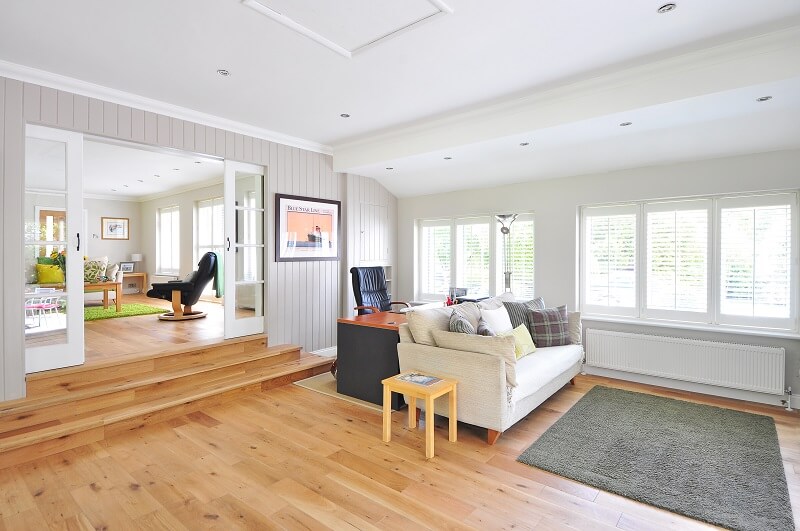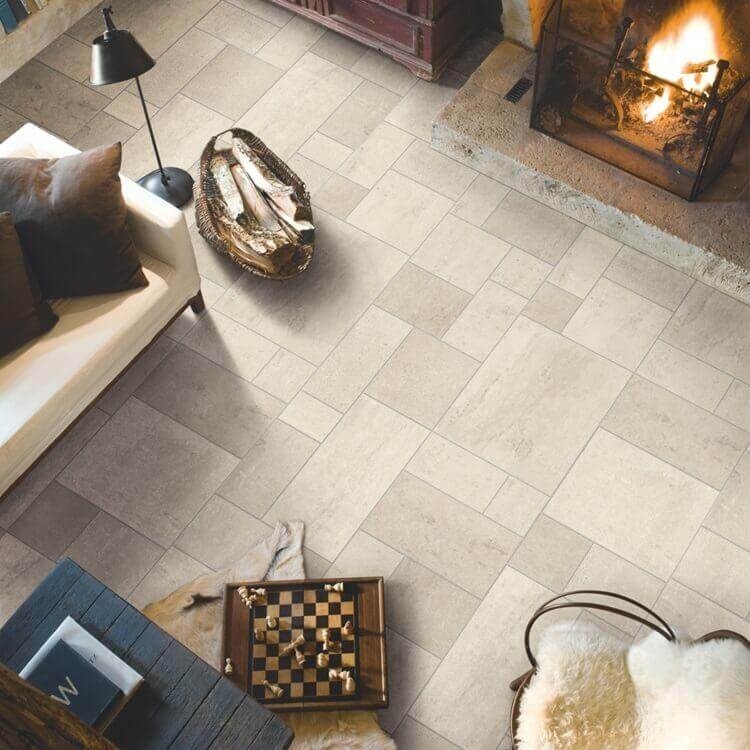Laminate vs vinyl flooring… it can be hard to know the differences and which will work best in your home. While similar in many ways, they have different properties that mean they perform better in some contexts over others. If you’re renovating your home and aren’t sure whether to choose vinyl or laminate flooring, read our blog on the differences and some top tips on choosing the right floor for your home. We have everything you need to know before you buy.
What is Laminate Flooring?
Laminate flooring is the most common and popular kind of flooring in both households and commercial premises today. Many people consider that, for modern homes, there is nothing like a laminate floor!
Laminate flooring is constructed from layers of synthetic wood using a lamination technique. The most unique thing about laminate flooring is that it is made up of 99% wood and therefore is a great alternative to natural hardwood while being more durable.
While previously the wood-look printed on as the final surface layer could look flat and therefore less realistic, 3D printing technology gives it the correct wooden texture so it looks very lifelike.
What is Vinyl Flooring?
Vinyl flooring is renowned as a luxury kind of flooring in the market. The flooring is ideal for your kitchen and bathroom because the vinyl flooring has anti-slip properties and is moisture absorbent as well. Moreover, vinyl flooring can practically fit into any style of home decor, whether it is contemporary or modern.
With standard vinyl flooring, the base layer is made from fiberglass covered in PVC vinyl and a plasticizer. This creates a sheet or tile which is then printed with the vinyl design which could be wood, stone or another pattern. The design layer is covered by multiple wear layers and no-wax polyurethane. Vinyl plank flooring, compared to tiles, has a thicker core layer of PVC vinyl.
The most important thing to note about vinyl flooring is that it’s not made from any wood material at all. It’s made entirely from plastic. This gives it excellent waterproof qualities, although it sometimes doesn’t look as much like real wood as laminate options do.
Side By Side Comparison
Vinyl
- 100% Plastic
- More moisture resistant
- Wood and stone effect (less lifelike)
- Best for kitchens & bathrooms
Laminate
- 90%+ Wood
- More vulnerable to moisture
- Wood and stone effect (more lifelike)
- Best for living & dining rooms, halls & bedrooms
Both floorings provide a great alternative over hardwood that’s more durable and versatile, but with the same natural look. Let’s breakdown the benefits and differences one at a time to help you know which would work better for different rooms in your home.
Material
The material of each type of flooring is where laminate and vinyl are the most different. Laminate is made almost entirely from wood, while vinyl is made completely from plastic. This means they have different properties that might influence which is most appropriate for you.
Waterproof
The main effect of the difference in material is on the waterproof qualities of vinyl and laminate. Laminate flooring is not appropriate for spaces in which it’s likely to get wet, such as in bathrooms. Moisture can enter the layers of the laminate and affect the adhesive that holds it together, ultimately ruining the board.
Vinyl, on the other hand, is completely waterproof. Moisture doesn’t have any effect on the tiles so they can be used in bathrooms, kitchens and other wet environments. Some people choose to use vinyl in entrance halls, for example, to protect the floor from moisture brought in from outdoors.
It is possible to get water resistant laminate. This is treated with a special coating of waterproof substance to protect the board. However, even waterproof laminate is not as waterproof as vinyl.
Appearance
The material that laminate and vinyl are made from also impacts their appearance. Laminate flooring, on the whole, looks more like real wood than its vinyl counterpart. This is because laminate is made from 99% real wood anyway, but also uses more advanced printing technology to create the pattern and texture.
However, there are lots of vinyl options that look highly realistic, just often not quite as much as laminate options.
If appearance is your main factor, then consider laminate flooring over vinyl. Quick Step laminate is a great choice as it’s one of the most realistic laminate flooring options on the market.
Thickness & Comfort
The material it’s made from also impacts the feel of the floor underfoot. Due to the wood material, laminate flooring is thicker. This means it feels more comfortable to walk on and also provides additional insulation over vinyl options.
Due to this, it can often be a good idea to choose vinyl flooring for bathrooms or kitchens where you need additional moisture protection, but laminate for other areas such as living rooms or bedrooms where comfort is more of a priority.
Foot Traffic
You should also consider the level of foot traffic in your space when choosing between laminate and vinyl. Because of its extra thickness, laminate is more hard-wearing and durable in areas of high foot traffic — for example, your hallway. You still can choose vinyl for areas that experience a lot of movement, but it might not last quite as long as laminate.
It’s a good idea with both laminate and vinyl to place mats on areas that receive the highest amount of repeated traffic. For example, in front of the kitchen sink or by the entrance door. This will help to prevent those areas from wearing more quickly compared to others.
Cost
Of course, cost is for most people one of the most important factors. Both laminate and vinyl flooring come with an extensive range of different prices according to the properties of individual products. However, laminate flooring on the whole tends to be less expensive than vinyl.
This is because vinyl is considered a luxury form of flooring, hence the name ‘Luxury Vinyl Tiles’. It has enhanced waterproof qualities that make it worth the extra expense in some areas of the home, but perhaps not the first choice for other rooms.
If cost is the primary factor, you might value laminate flooring over vinyl — especially for rooms that don’t need protection from water.
Different Rooms
As already mentioned, it will depend on which room you’re looking to redecorate as to what kind of flooring is most appropriate. If you’re revamping your bathroom, then vinyl flooring is the best option. It provides protection from water that can’t be matched by laminate.
However, if you’re looking for a new floor for your living room, then laminate might be the better choice. It is less water resistant, but is cheaper, more comfy to walk on and provides more insulation.
For more information on our laminate flooring or vinyl, please get in touch today. You can contact us either by phone, email or by filling out the contact form on our website. We try to respond within 24 hours of all enquiries.

